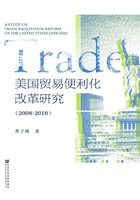
Abstract
Since the end of World War II, global tariff barriers have been sub-stantially reduced under the promotion of GATT and the WTO. However, trade inefficiency and its related costs have increasingly stifle international trade growth. The issue of trade facilitation, which aims at eliminating the institutional obstacles and costs in cross-border trade, has gradually come into focus as a growing concern of the governments of developed econo-mies. Subsequent to the disastrous financial crisis in 2008, the world's e-conomy suffered severe downturns, global trade in goods reduced substantially, and trade protectionism resurfaced. Against this background, not only developed countries, more and more developing countries have begun the process of trade facilitation reform. Since then, trade facilitation has become a foundational trend of the global economy and trade development. This issue has also become the focus worldwide academic research.
As a result of the urgent need for economic revitalization the financial crisis faced by the Obama administration, the US opened up a new round of trade facilitation reform to assist its economy to recover from the recession. Similarly, as the largest trading country in the world, China has also suf-fered from the impact of financial crisis, and it continues to face the chal-lenges of recovery both at home and abroad. Standing at a new historical starting point of the“13th Five-year Strategy Plan”, trade facilitation has been placed at the pinnacle of China's trade strategy over the next five years. Thus, systematic study of U. S. trade facilitation reform is not only a useful complement to the current research, but also significant to China's trade facilitation policy which is still in its infancy.
This dissertation consists of seven chapters. Based upon the literature review, this dissertation provides the theoretical basis upon which the analysis for trade facilitation shall rest. The second chapter provides an in-depth examination of the international background and domestic factors faced by the Obama administration in formulating its new round of trade facilitation reform. The following chapter summarizes the strategic framework, primary policies and measures that Obama administration has implemented, and compares the provisions to reforms implemented in the past. Chapter five conducts a quantitative evaluation the reform policies effects on both of promoting the trade facilitation level and reducing trade cost of American ex-ports in goods, as well as the factors which restricted the policy implemen-tation. Chapter six qualitatively analyzes the growth in U. S. exports and then quantitatively assesses using the gravity model, the export-promotion's effect on the main strategic policies and measures since these trade facilita-tion policies were initiated in 2009. The last chapter concludes with a few enlightenments for China's trade facilitation in the future.
Synthesizing all analysis, this dissertation draws to several conclusions: ①The Obama administration's trade facilitation reform has set a good example for trade facilitation theories: through optimizing and innovating the institution, the Obama administration's trade facilitation reform has in-deed effectively reduced trade cost of American exports in goods, enlarged the exports scale and helped tap into its trade potential. Obama administration's trade facilitation reform also shows that the trade liberalization is still the best option for realizing positive trade growth in a world bristling with non-tariff barriers. Moreover, understanding and respecting the influence of historical factors is crucial to achieve effective institutional change.②To promote the trade development in the Global Village where the inter-ests of countries are interconnected, the United States should undertake the responsibility as an economic super power and cooperate with trading part-ners sincerely and advancing stable, balanced and sustainable growth of the world economy. ③The export promoting facilitation reform with the principle of sharing economy and Export infrastructure facilitation reform with the pur-pose of enhancing global connectivity have the most significant effects on U. S. exports growth. This result evidences the necessity to break the stran-glehold and innovate the existing institution to maximize the reform benefit.④The Obama administration's trade facilitation reform has not fully achieved its target. Many hindering factors have limited the full impact of the Obama trade facilitation reforms. Not only the domestic factors such as the U. S. political system of separation of powers, the deep seeded political po-larization between the Democrats and Republicans Parties, the management decentralization of Federal and local governments, the long-term pressure of deficit spending, but also the populist uprising of anti-globalization, and the difficulty in implementing coordination of international rules have im-paired the full effects of the Obama trade facilitation reform policies. As for the Trump administration, continuing to remove additional restrictive obsta-cles will reinforce the full benefit of the reforms.
Based on the above conclusions, this paper provides a road map for the development of China's future trade and facilitation policies. First, as the world's second largest economy(next to the U. S.), undertake the responsibility to promote new-globalization policies which are characterized by open, balanced, inclusive and benefit-sharing economic growth; secondly, complete the top design of trade facilitation reform in the near future and encourage innovation as the core principle in its facilitation reform;thirdly, accelerate the modernization of export-promotion system and build a citizen-oriented, service-oriented and sharing-oriented government; finally, undertake further infrastructure development and improvements to strengthen global geographic, technological, cultural and institutional con-nectivity with the rest of the world.
There will be much uncertainty of the economic growth outlook in the Trump Era. The the development of China-U. S. economic and trade relations also faces both opportunities and challenges. Trump's emphasis on fairness and balance of trade, the flexibility of president's right of implementing trade policies, the anti-China preference of main cabinet members in trade department portend the upgrading of trade frictions between China and the United States. However, the infrastructure policy of Trump Administration will provide tremendous opportunity for Chinese companies. The meeting between the president Trump and the Chinese president Xi Jinping has a-chieved positive results which sets the tone for the development of China-U. S. economic and trade relations in the future. Thus, strengthening the communication and putting efforts to establish new pattern of relationship between China and US will be the win-win solution.